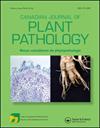First report of 16SrII-V phytoplasma associated with cowpea (Vigna unguiculata) phyllody in China
IF 1.5
4区 农林科学
Q3 PLANT SCIENCES
引用次数: 0
Abstract
Abstract Cowpea plants exhibiting virescence, phyllody and little leaf symptoms were observed in the fields of Zhanjiang City, Guangdong province of China in October 2020. Total DNA was extracted from symptomatic cowpea leaves. Using phytoplasma universal primer pairs (R16mF2/R16mR1, P1/P7) and a secA primer pair (secAfor1/secArev3), expected PCR fragments of approximately 1400, 1800 and 800 bp were amplified from all symptomatic cowpea leaves. MUSCLE analysis revealed that the representative 16S rRNA gene sequence of cowpea phyllody phytoplasma (CPP) shared 98.67% nucleotide identity with the reference strain WBDL of ‘Ca. Phytoplasma aurantifolia’ (GenBank accession number U15442); and 100% nucleotide identity with 16SrII-V phytoplasmas associated with ‘Praxelis clematidea’ phyllody (GenBank accession number KY568717); ‘Desmodium triflorum’ little leaf (GenBank accession number MT452308); and ‘Ixeris chinensis’, ‘Emilia sonchifolia’, and ‘Desmodium ovalifolium’ witches’ broom (GenBank accession number MT416114, MT420682 and MK956144, respectively). Phylogenetic analyses based on the 16S rRNA and secA gene sequences revealed that the CPP strain clustered with the 16SrII-V subgroup and 16SrII group, respectively. Virtual restriction fragment length polymorphism analysis of the 16S rRNA sequence revealed that CPP was associated with the 16SrII-V subgroup. To our knowledge, this is the first report of the16SrII-V subgroup of phytoplasmas associated with cowpea phyllody disease.16SrII-V植原体与我国豇豆(Vigna unguiculata)叶序相关的首次报道
2020年10月,在广东省湛江市的田间观察到豇豆植株呈现出绿色、叶状和小叶症状。从有症状的豇豆叶片中提取总DNA。利用植物原体通用引物对(R16mF2/R16mR1, P1/P7)和secA引物对(secAfor1/secArev3),从所有有症状的豇豆叶片中扩增出约1400、1800和800 bp的预期PCR片段。MUSCLE分析显示,豇豆根状植物原体(CPP)的代表性16S rRNA基因序列与参考菌株WBDL的核苷酸同源性为98.67%。金叶植物原体(Phytoplasma aurantifolia) (GenBank登录号U15442);与‘Praxelis clematidea’相关的16SrII-V植物原体的100%核苷酸同源性(GenBank登录号KY568717);‘三花菊’小叶(GenBank登录号MT452308);和' Ixeris chinensis ', ' Emilia sonchifolia '和' Desmodium ovalifolium ' witch ' broom ' (GenBank登录号分别为MT416114, MT420682和MK956144)。基于16S rRNA和secA基因序列的系统发育分析显示,CPP菌株分别属于16SrII- v亚群和16SrII亚群。对16S rRNA序列进行虚拟限制片段长度多态性分析,发现CPP与16SrII-V亚群相关。据我们所知,这是第一次报道与豇豆病相关的植物原体16srii - v亚群。
本文章由计算机程序翻译,如有差异,请以英文原文为准。
求助全文
约1分钟内获得全文
求助全文
来源期刊
CiteScore
4.50
自引率
5.00%
发文量
56
审稿时长
6-12 weeks
期刊介绍:
Canadian Journal of Plant Pathology is an international journal which publishes the results of scientific research and other information relevant to the discipline of plant pathology as review papers, research articles, notes and disease reports. Papers may be submitted in English or French and are subject to peer review. Research articles and notes include original research that contributes to the science of plant pathology or to the practice of plant pathology, including the diagnosis, estimation, prevention, and control of plant diseases. Notes are generally shorter in length and include more concise research results. Disease reports are brief, previously unpublished accounts of diseases occurring on a new host or geographic region. Review papers include mini-reviews, descriptions of emerging technologies, and full reviews on a topic of interest to readers, including symposium papers. These papers will be highlighted in each issue of the journal and require prior discussion with the Editor-in-Chief prior to submission.

 求助内容:
求助内容: 应助结果提醒方式:
应助结果提醒方式:


